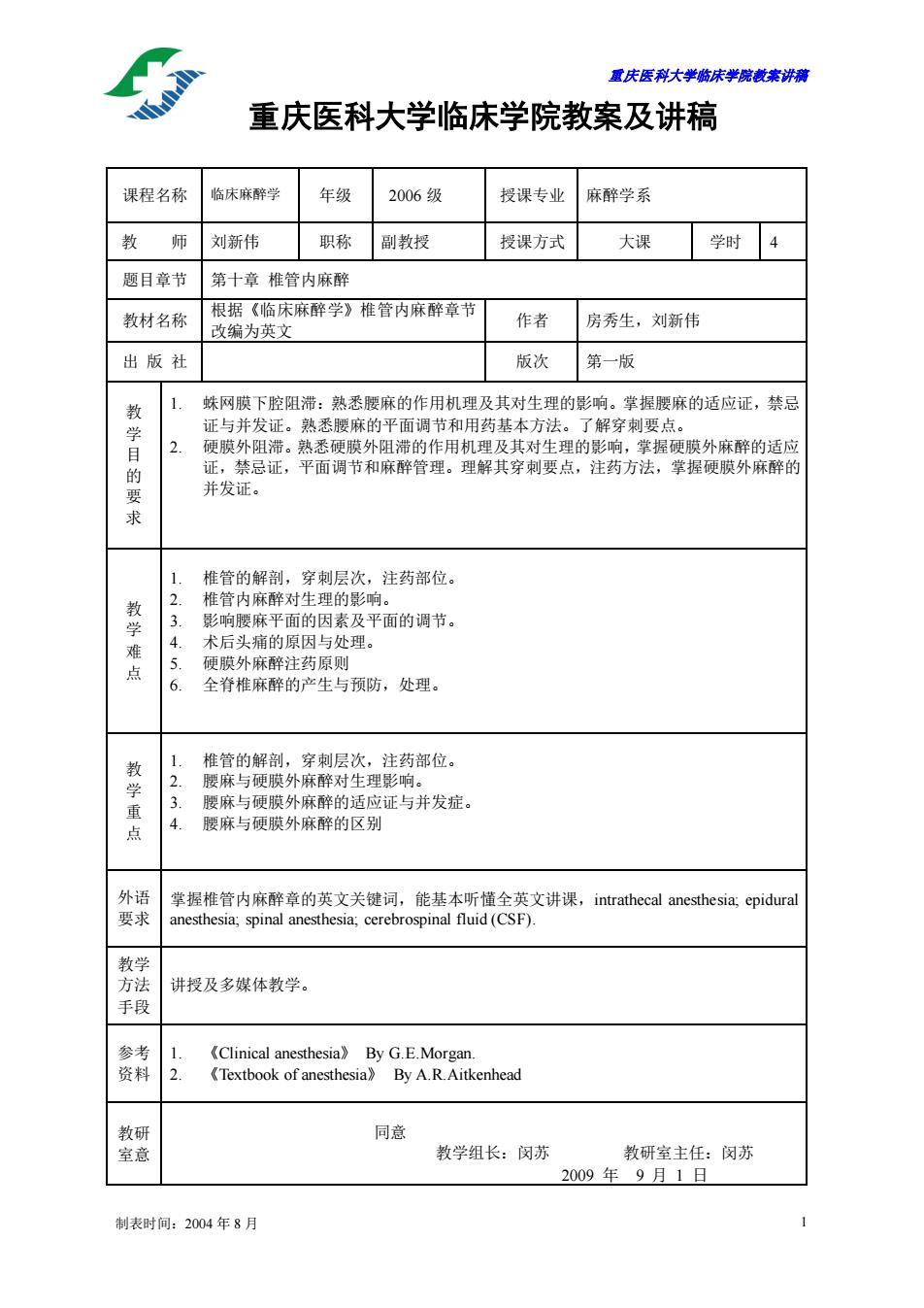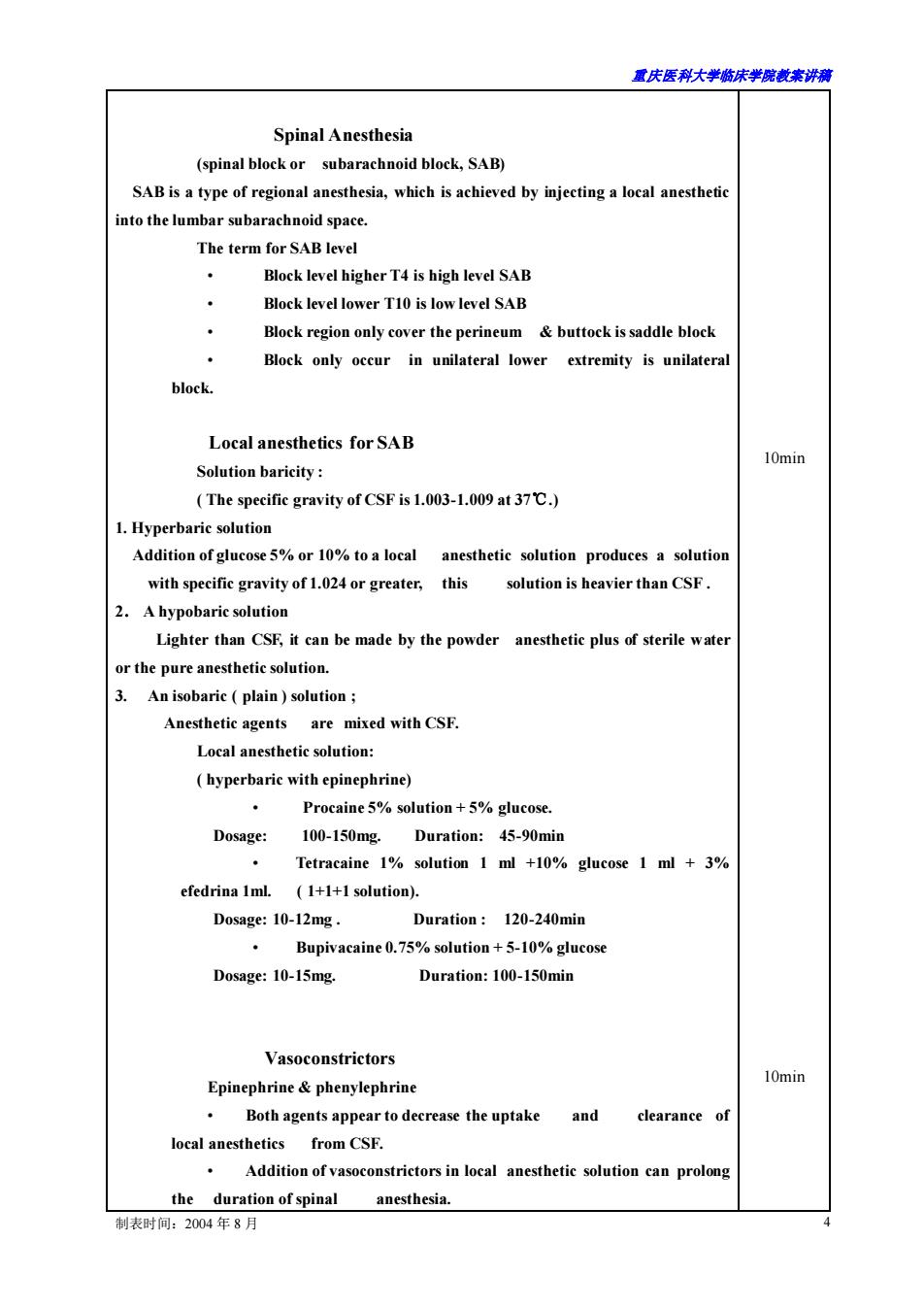
置庆医科大学脑床学院载未讲满 重庆医科大学临床学院教案及讲稿 课程名称临床麻醉学 年级 2006级 授课专业 麻醉学系 教师刘新伟 职称副教授 授课方式 大课 学时4 题目章节第十章椎管内麻醉 教材名称银据麻醉字椎管内麻醉章作者 房秀生,刘新伟 改编为英文 出版社 版次第一版 1. 蛛网膜下腔阻滞:熟悉腰麻的作用机理及其对生理的影响。掌握腰麻的适应证,禁忌 证与并发证。熟悉腰麻的平面调节和用药基本方法。了解穿刺要点。 学目的要求 硬膜外阻滞。熟悉硬膜外阻滞的作用机理及其对生理的影响,掌握硬膜外麻醉的适应 证,禁忌证,平面调节和麻醉管理。理解其穿刺要点,注药方法,掌握硬膜外麻醉的 并发证。 椎管的解剖,穿刺层次,注药部位。 2. 椎管内麻醉对生理的影响。 3. 影响腰麻平面的因素及平面的调节。 难点 4, 术后头痛的原因与处理。 椎管的解剖,穿刺层次,注药部位。 题与陌时从碎生理品影响 3 腰麻与硬膜外麻醉的适应证与并发症, 4 点 腰麻与硬膜外麻醉的区别 外 掌握椎管内麻醉章的英文关键词,能基本听懂全英文讲课,intrathecal anesthesia,epidural 求 nesthesia;spinal anesthesia;cerebrospinal fluid (CSF). 拼授及多媒体教学 《Clinical anesthesia》ByG.E.Morgan. 《Textbook of anesthesia》ByA.R.Aitkenhead 教研 同意 室意 教学组长:闵苏 教研室主任:闵苏 2009年9月1日 制表时间:2004年8月
重庆医科大学临床学院教案讲稿 制表时间:2004 年 8 月 1 重庆医科大学临床学院教案及讲稿 课程名称 临床麻醉学 年级 2006 级 授课专业 麻醉学系 教 师 刘新伟 职称 副教授 授课方式 大课 学时 4 题目章节 第十章 椎管内麻醉 教材名称 根据《临床麻醉学》椎管内麻醉章节 改编为英文 作者 房秀生,刘新伟 出 版 社 版次 第一版 教 学 目 的 要 求 1. 蛛网膜下腔阻滞:熟悉腰麻的作用机理及其对生理的影响。掌握腰麻的适应证,禁忌 证与并发证。熟悉腰麻的平面调节和用药基本方法。了解穿刺要点。 2. 硬膜外阻滞。熟悉硬膜外阻滞的作用机理及其对生理的影响,掌握硬膜外麻醉的适应 证,禁忌证,平面调节和麻醉管理。理解其穿刺要点,注药方法,掌握硬膜外麻醉的 并发证。 教 学 难 点 1. 椎管的解剖,穿刺层次,注药部位。 2. 椎管内麻醉对生理的影响。 3. 影响腰麻平面的因素及平面的调节。 4. 术后头痛的原因与处理。 5. 硬膜外麻醉注药原则 6. 全脊椎麻醉的产生与预防,处理。 教 学 重 点 1. 椎管的解剖,穿刺层次,注药部位。 2. 腰麻与硬膜外麻醉对生理影响。 3. 腰麻与硬膜外麻醉的适应证与并发症。 4. 腰麻与硬膜外麻醉的区别 外语 要求 掌握椎管内麻醉章的英文关键词,能基本听懂全英文讲课,intrathecal anesthesia; epidural anesthesia; spinal anesthesia; cerebrospinal fluid (CSF). 教学 方法 手段 讲授及多媒体教学。 参考 资料 1. 《Clinical anesthesia》 By G.E.Morgan. 2. 《Textbook of anesthesia》 By A.R.Aitkenhead 教研 室意 同意 教学组长:闵苏 教研室主任:闵苏 2009 年 9 月 1 日

露庆医科大学临床半蕊藏素讲满 教学内容 辅助手段 时间分配 Intrathecal Anesthesia 多媒体 10min Intrathecal anesthesia. Intrathecal anesthesia result in sympathetic block,sensory analgesia,and motor olock (depending on dose,concentration,or volume of local anesthetic)by loca anesthetic is injected into subarachnoid space(spinal anesthesia )or the epidural space epidural anesthesia)and bathes the nerve roots in the subarachnoid space or epidura space.respectively Intrathecal block is divided into two elasses Subarachnoid block(spinal block):Local anesthetic is injected into subarachnoid space. Epidural block:Local anesthetic is injected into the epidural space Anatomy Vertebral column 7 cervical (C). 12 thoracic (T). 5lumbar (L). 5 sacral (S)fused as the sacrum, 。 4small coccygeal vertebra (Co)that form the coccyx VERTEBRA 10min The vertebral arch encloses the vertebral foramen,each vertebral arch has two parts,that is pedicle (root)and lamina. Pedicles have large notches on thei inferior surface and smaller notches on their superior surface.Notches from adjacent vertebrae form intervertebral foramina,through which nerve roots exit the spina column. Sacrum Coceyx The sacral hiatus leads into the sacral canal,the inferior end of the vertebral canal Ligamentum of vertebral column Supraspinous ligament Interspinous ligament Ligamentum flavum(the yollow ligament) Spinal cord spinal cord extends from the foramen magnum to the level of LI in adults. The anterior and posterior nerve rootsat each spinal leveljoin one another. Cauda equina(horse's tail). 制表时间:2004年8月
重庆医科大学临床学院教案讲稿 制表时间:2004 年 8 月 2 教学内容 辅助手段 时间分配 Intrathecal Anesthesia Intrathecal anesthesia. Intrathecal anesthesia result in sympathetic block, sensory analgesia, and motor block (depending on dose, concentration, or volume of local anesthetic) by local anesthetic is injected into subarachnoid space ( spinal anesthesia ) or the epidural space ( epidural anesthesia ) and bathes the nerve roots in the subarachnoid space or epidural space, respectively Intrathecal block is divided into two classes Subarachnoid block (spinal block): Local anesthetic is injected into subarachnoid space. Epidural block: Local anesthetic is injected into the epidural space. Anatomy Vertebral column • 7 cervical (C), • 12 thoracic (T), • 5 lumbar (L), • 5 sacral (S) fused as the sacrum, • 4 small coccygeal vertebra (Co) that form the coccyx VERTEBRA The vertebral arch encloses the vertebral foramen, each vertebral arch has two parts, that is pedicle (root) and lamina. Pedicles have large notches on their inferior surface and smaller notches on their superior surface. Notches from adjacent vertebrae form intervertebral foramina, through which nerve roots exit the spinal column. Sacrum & Coccyx: The sacral hiatus leads into the sacral canal, the inferior end of the vertebral canal . Ligamentum of vertebral column • Supraspinous ligament • Interspinous ligament • Ligamentum flavum(the yollow ligament) Spinal cord The spinal cord extends from the foramen magnum to the level of L1 in adults. The anterior and posterior nerve roots at each spinal level join one another. Cauda equina( horse’s tail). 多媒体 10min 10min

置庆医科大半脑床半院载未讲满 Spinal meninges spinal cord 8- spinal dura mater 9-arachnoid mater 10-spinal pia mater Spinal space Epidural space Subdural space Subarachnoid space Spinal nerves dermatomic distribution T2-manubrium of sternum T4-mippl T6-xiphoid process T8-between T6&T10 T10-navel symphysis Physiologic Effects of Intrathecal Anesthesia Nerve blockade sequence Sympathetic-sensory-motor-sheathed nerve Differential nerve blockade level Sympathetic blockade that may be two segments level higher than the sensory block, which in turn is two segments higher than the motor blockade. Respiratory system 10min 1.Low spinal block or low epidural block has no effect on the respiratory system. 2.Motor blockade extending to the roots of the phrenic nerves(C3-5)causes apnea 3.High thoracic level blockade can cause loss of intercostal muscle activity,ther is a marked decrease in vital capacity. Cardiovascular system 1.Decrease blood pressure. 2.Reduction in cardiac output and cardiac contractility. 3.Bradycardia.(block T1 -T4 ) Gastrointestinal system Increase intestinal contraction 2.Nausea,retching or vomiting: 制表时间:2004年8月
重庆医科大学临床学院教案讲稿 制表时间:2004 年 8 月 3 Spinal meninges 7- spinal cord 8- spinal dura mater 9- arachnoid mater 10- spinal pia mater Spinal space • Epidural space • Subdural space • Subarachnoid space Spinal nerves dermatomic distribution T2 - manubrium of sternum T4 - nippl T6 -xiphoid process T8 - between T6 & T10 T10 - navel T12 - pubic symphysis Physiologic Effects of Intrathecal Anesthesia Nerve blockade sequence Sympathetic - sensory - motor – sheathed nerve. Differential nerve blockade level Sympathetic blockade that may be two segments level higher than the sensory block, which in turn is two segments higher than the motor blockade. Respiratory system 1. Low spinal block or low epidural block has no effect on the respiratory system. 2. Motor blockade extending to the roots of the phrenic nerves(C3-5)causes apnea. 3. High thoracic level blockade can cause loss of intercostal muscle activity, there is a marked decrease in vital capacity. Cardiovascular system 1. Decrease blood pressure . 2. Reduction in cardiac output and cardiac contractility. 3. Bradycardia.( block T1 –T4 ). Gastrointestinal system 1. Increase intestinal contraction. 2. Nausea, retching or vomiting: 10min

重庆医科大学临床半院麦来讲满 Spinal Anesthesia (spinal block or subarachnoid block,SAB) SAB is a type of regional anesthesia,which is achieved by injecting a local anestheti into the lumbar subarachnoid space. The term for SAB level Block level higher T4 is high level SAB Block level lower T10 is low level SAB Block region only cover the perineum buttock is saddle block Block only occur in unilateral lower extremity is unilatera block. Local anesthetics for SAB Solution baricity: 10min (The speeifie gravity of CSF is 1.003-1.009 at 37C.) 1.Hyperbaric solution Addition of glucose5%or10%to a local anesthetic solution produces a solution with specific gravity of 1.024 or greater,this solution is heavier than CSF 2.A hypobaric solution Lighter than CSF,it can be made by the powder anesthetic plus of sterile wate or the pure anesthetic solution. 3. An isobaric(plain)solution; Anesthetic agents are mixed with CSF. Local anesthetic solution: (hyperbaric with epinephrine) Procaine 5%solution+5%glucose. Dosage: 100-150mg.Duration:45-90min Tetracaine 1%solution 1 ml +10%glucose 1 ml +3% efedrina Iml.(1+1+1 solution). Dosage:10-12mg. Duration 120-240min Bupivacaine 0.75%solution+5-10%glucose Dosage:10-15mg. Duration:100-150min Vasoconstrictors Epinephrine phenylephrine 10min Both agents appear to decrease the uptake and clearance of local anestheties from CSF. Addition of vasoconstrictors in local anesthetic solution can prolong the duration of spinal anesthesia. 制表时间:2004年8月
重庆医科大学临床学院教案讲稿 制表时间:2004 年 8 月 4 Spinal Anesthesia (spinal block or subarachnoid block, SAB) SAB is a type of regional anesthesia, which is achieved by injecting a local anesthetic into the lumbar subarachnoid space. The term for SAB level • Block level higher T4 is high level SAB • Block level lower T10 is low level SAB • Block region only cover the perineum & buttock is saddle block • Block only occur in unilateral lower extremity is unilateral block. Local anesthetics for SAB Solution baricity : ( The specific gravity of CSF is 1.003-1.009 at 37℃.) 1. Hyperbaric solution Addition of glucose 5% or 10% to a local anesthetic solution produces a solution with specific gravity of 1.024 or greater, this solution is heavier than CSF . 2. A hypobaric solution Lighter than CSF, it can be made by the powder anesthetic plus of sterile water or the pure anesthetic solution. 3. An isobaric ( plain ) solution ; Anesthetic agents are mixed with CSF. Local anesthetic solution: ( hyperbaric with epinephrine) • Procaine 5% solution + 5% glucose. Dosage: 100-150mg. Duration: 45-90min • Tetracaine 1% solution 1 ml +10% glucose 1 ml + 3% efedrina 1ml. ( 1+1+1 solution). Dosage: 10-12mg . Duration : 120-240min • Bupivacaine 0.75% solution + 5-10% glucose Dosage: 10-15mg. Duration: 100-150min Vasoconstrictors Epinephrine & phenylephrine • Both agents appear to decrease the uptake and clearance of local anesthetics from CSF. • Addition of vasoconstrictors in local anesthetic solution can prolong the duration of spinal anesthesia. 10min 10min

重庆医科大半临床半院载案讲满 Dosage:Epinephrine(0.1-0.2mg). Assessing blockade level: The sensory level of blockade can be assessed with pinprick or ice,the level of sympathectomy isassessed by measuring skin temperature. The complete block of motor nerves is manifested inability to move the legs or foot. Factors affecting spread of hyperbaric 1.spinal solution 2.Patient's position "saddle block"keeping the patient sitting for 3-5 min afterinjection of 1-2ml of hyperbaric solution. "unilateral block"keeping the patient on lateral position. Drug dosage solution volume. 3.Speed ofinjection. The rate of iniection is Iml/5 sec. 4.Lumber puncture site 5.Needle bevel direction. SAB level management (Hyperbaric solution) Complications of SAB 1.Hypotension 10min Reasons:vessels dilatation;increased blood pooling; blood flow decreased return to heart.Cardiac contractility decreased Augmented by: Hypovolemia Changes in position Bradycardia Treatment Prevention:Use of erystalloid or colloid fluids IV 10-20ml/kg for volume loading pre-lumber puncture. Increase fluid administration. Mask oxygen inhale. Drug:Ephedrine 10-15 mg IV. Bradycardia Reasons: Spinal block level higher than T4,which may block the cardia sympathetic accelerator fibers(T1-T4),then bradycardia may occur. 制表时间:2004年8月
重庆医科大学临床学院教案讲稿 制表时间:2004 年 8 月 5 Dosage: Epinephrine(0.1-0.2mg). Assessing blockade level : • The sensory level of blockade can be assessed with pinprick or ice, the level of sympathectomy is assessed by measuring skin temperature. The complete block of motor nerves is manifested inability to move the legs or foot. Factors affecting spread of hyperbaric 1. spinal solution 2. Patient’s position • “saddle block” keeping the patient sitting for 3-5 min after injection of 1-2ml of hyperbaric solution . • “unilateral block” keeping the patient on lateral position. Drug dosage & solution volume . 3. Speed of injection. The rate of injection is 1ml / 5 sec. 4. Lumber puncture site. 5. Needle bevel direction. SAB level management ( Hyperbaric solution ) Complications of SAB 1. Hypotension Reasons: vessels dilatation; increased blood pooling; blood flow decreased return to heart. Cardiac contractility decreased. Augmented by: • Hypovolemia • Changes in position • Bradycardia Treatment • Prevention: Use of crystalloid or colloid fluids IV 10-20ml/kg for volume loading pre-lumber puncture. • Increase fluid administration. • Mask oxygen inhale. Drug: Ephedrine 10-15 mg IV. Bradycardia Reasons: Spinal block level higher than T4 , which may block the cardiac sympathetic accelerator fibers (T1- T4),then bradycardia may occur. 10min